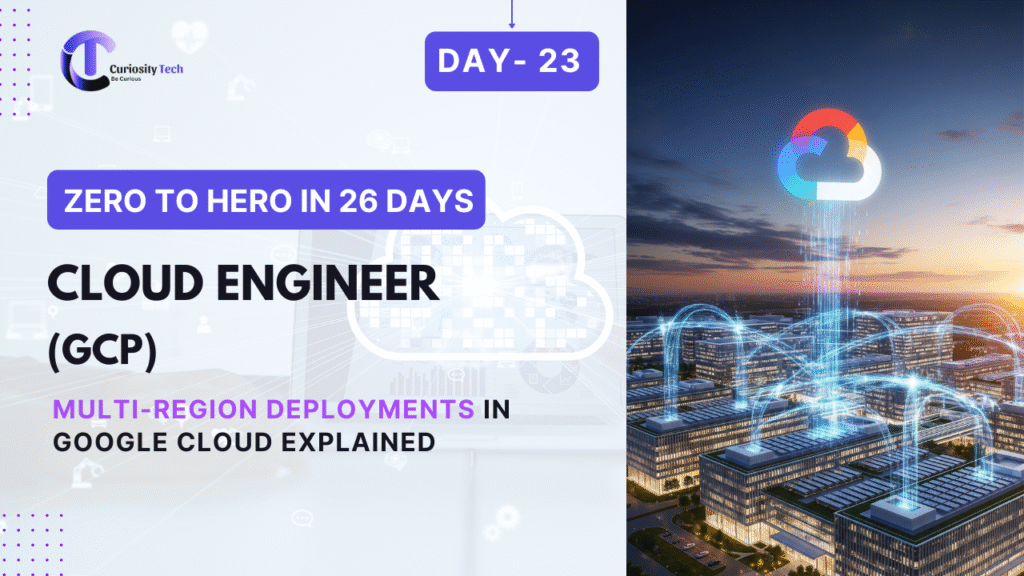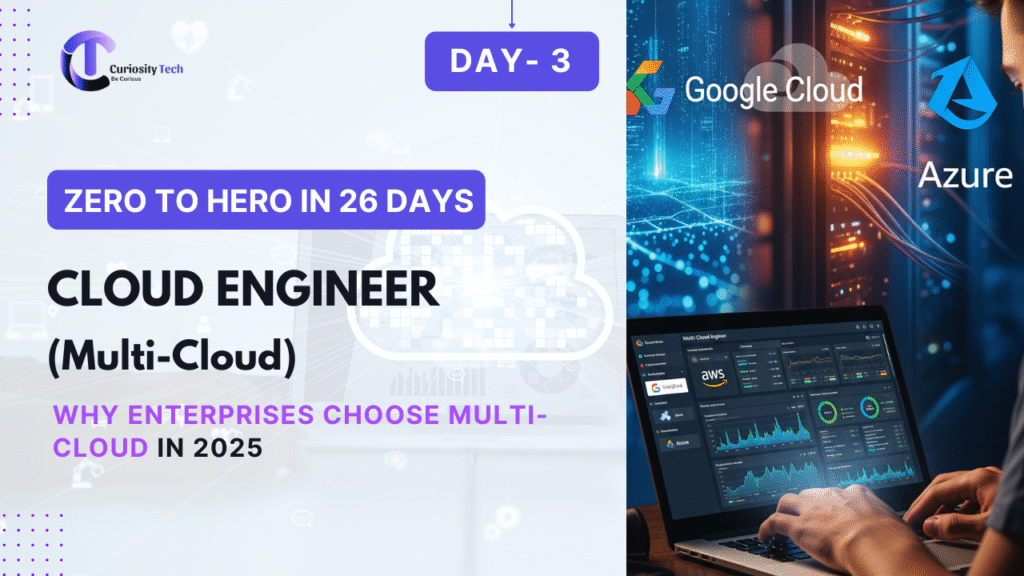Introduction
In a global, highly digital world, ensuring that applications are highly available, low-latency, and resilient to failures is essential. Multi-region deployment in Google Cloud Platform (GCP) allows organizations to deploy their applications, databases, and services across multiple geographic regions, ensuring fault tolerance, disaster recovery, and superior user experience.
At Curiosity Tech, cloud engineers are trained to design robust multi-region architectures, enabling organizations to maintain business continuity and achieve near-zero downtime across geographies.
Why Multi-Region Deployment Matters
High Availability: If one region goes down, workloads can continue in another.
Disaster Recovery: Critical for business continuity during regional outages.
Reduced Latency: Serve users from the closest region for faster response times.
Compliance & Data Residency: Deploy workloads in specific regions to meet local regulations.
Scalability: Automatically scale applications to multiple regions to handle spikes in traffic.
GCP Services Supporting Multi-Region Deployment
Service
Multi-Region Feature / Use Case
Cloud Storage
Multi-region buckets replicate data across regions for durability.
Cloud SQL
High Availability configuration with cross-region failover.
Spanner
Globally distributed relational database with synchronous replication.
BigQuery
Data warehouses accessible globally with low-latency queries.
Cloud Run & GKE
Deploy services in multiple regions using global load balancers.
Cloud Load Balancing
Automatically routes traffic to the nearest healthy region.
Cloud CDN
Delivers content from edge locations worldwide for faster response.
Core Concepts in Multi-Region Architecture
Active-Active Deployment:
Services are actively running in multiple regions simultaneously.
Traffic is distributed across regions for better performance.
Example: A retail website serving users from the US, Europe, and Asia.
Active-Passive Deployment:
Primary region handles all traffic, secondary region remains idle.
Secondary region is activated automatically if the primary fails.
Example: Banking systems with strict disaster recovery requirements.
Global Load Balancing:
Use GCP Global HTTP(S) Load Balancer to distribute traffic across multiple regions.
Health checks detect unhealthy instances and redirect traffic to healthy regions.
Data Replication & Consistency:
Cloud Spanner provides strong consistency globally.
Cloud Storage Multi-Region ensures durability by replicating objects.
Cloud SQL HA supports automated failover to standby in another region.
Step-by-Step Multi-Region Deployment in GCP
Step 1: Choose Target Regions
Select regions close to your user base.
Consider compliance, latency, and cost factors.
Step 2: Deploy Applications
For containerized apps: Deploy to GKE clusters in multiple regions.
For serverless apps: Deploy Cloud Run services in each region.
Step 3: Configure Data Services
Use Cloud SQL HA for relational databases across regions.
Use Cloud Spanner for globally distributed relational data.
Use Cloud Storage multi-region buckets for static content.
Step 4: Set Up Global Load Balancer
Create a Global HTTP(S) Load Balancer.
Enable cross-region failover and health checks.
Step 5: Enable CDN & Edge Caching
Use Cloud CDN to cache content closer to users.
Reduce latency and improve performance for global users.
Step 6: Monitoring & Alerts
Use Cloud Monitoring and Logging for all regions.
Set up alerts for regional failures, traffic spikes, and latency issues.
Diagram Concept: Multi-Region Architecture
[Global Users]
|
[Global HTTP(S) Load Balancer]
/ | \
[US Region Cluster] [Europe Cluster] [Asia Cluster]
| | |
[Cloud SQL / Spanner Multi-Region Replication]
|
[Cloud Storage Multi-Region Bucket]
Practical Example: Global E-Commerce Platform
Scenario: An e-commerce website serving customers worldwide.
Application Deployment:
Backend services deployed on GKE clusters in US, Europe, and Asia.
Frontend served via Cloud Run in each region.
Database Deployment:
Customer data stored in Cloud Spanner for global consistency.
Product images and static content in Cloud Storage multi-region buckets.
Traffic Management:
Global HTTP(S) Load Balancer routes traffic to the nearest healthy region.
Failover enabled: if Europe region fails, users automatically routed to US or Asia.
Performance Optimization:
Cloud CDN caches static content for faster load times.
Health checks monitor application instances and redirect traffic in case of failure.
Table: Multi-Region Components Example
| Component | GCP Service Used | Multi-Region Feature |
|———————–|———————————-|—————————————-|
| Frontend App | Cloud Run / GKE | Deploy in multiple regions |
| Backend APIs | GKE / Cloud Run | Active-active deployment |
| Database | Cloud Spanner / Cloud SQL HA | Global replication / cross-region failover |
| Static Content | Cloud Storage + Cloud CDN | Multi-region bucket + edge caching |
| Load Balancing | Global HTTP(S) Load Balancer | Traffic routing & failover |
| Monitoring | Cloud Monitoring & Logging | Multi-region observability |
Best Practices for Multi-Region Deployments
Understand User Geography: Deploy resources near users to minimize latency.
Use Active-Active for Critical Applications: Ensure uninterrupted service globally.
Enable Automated Failover: Use GCP load balancer health checks for seamless traffic routing.
Monitor & Log All Regions: Centralized monitoring ensures rapid issue detection.
Implement Data Consistency Strategies: Use Spanner for strong consistency, eventual consistency where acceptable.
Optimize Costs: Right-size resources per region and consider sustained use discounts.
Test Failover Regularly: Simulate regional outages to validate HA architecture.
Advanced Techniques
Multi-Cloud Expansion: Extend multi-region deployment across AWS or Azure using Anthos.
Disaster Recovery Plans: Define RTO and RPO for critical workloads.
Geo-Partitioning Databases: Split data across regions to improve latency and reduce replication overhead.
Edge Computing Integration: Deploy latency-sensitive workloads at edge locations with Cloud Run or GKE.
Conclusion
Multi-region deployment in GCP is essential for highly available, resilient, and performant applications. By leveraging services like GKE, Cloud Run, Cloud Spanner, Cloud Storage, and Global Load Balancing, cloud engineers can deliver low-latency experiences globally while ensuring disaster recovery and compliance.
At Curiosity Tech, engineers are trained in multi-region deployment strategies, performance optimization, and failover mechanisms, equipping them to handle enterprise-scale global applications efficiently and reliably.
Day 23 – Multi-Region Deployments in Google Cloud Explained



